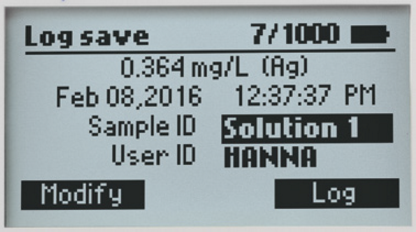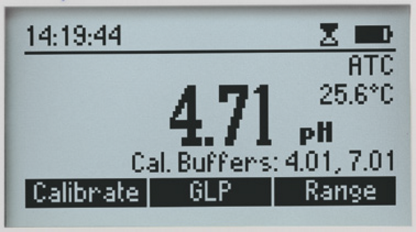HI83325 is a compact, multiparameter photometer for use in the environmental lab or in the field. The meter is one of the most advanced photometers available with a innovative optical design that utilizes a reference detector and focusing lens to eliminate errors from changes in the light source and from imperfections in the glass cuvette. This meter has 9 different programmed methods measuring 8 key plant nutrient water quality parameters and also offers an absorbance measurement mode for performance verification and for users that would like to develop their own concentration versus absorbance curves. Plant nutrient-specific parameters include potassium, calcium, and magnesium.
To save valuable laboratory benchtop space, the HI83325 doubles as a professional pH meter with its digital pH/temperature electrode input. Now one meter can be used for both photometric and pH measurements.
Unparalleled performance from a benchtop photometer
Save valuable bench space with one meter that works both as a photometer and as a laboratory pH meter

The HI83325 benchtop photometer measures 8 different key water quality parameters using 9 different methods. This photometer features an innovative optical system that uses LEDs, narrow band interference filters, focusing lens and both a silicon photodetector for absorbance measurement and a reference detector to maintain a consistent light source ensures accurate and repeatable photometric readings every time.
Consistent and thorough monitoring of plant nutrients is essential to maintaining healthy growth and reproduction. This is easy with the HI83325, a comprehensive way to monitor vital plant nutrients such as potassium, calcium and magnesium. Required in large quantities, potassium plays a vital role in water uptake and enzyme regulation. Calcium helps to strengthen plant cell walls protecting against heat stress while magnesium helps build a strong immune system.
A digital pH electrode input allows the user to measure pH by a traditional glass electrode. The digital pH electrode has a built in microchip within the probe that stores all of the calibration information. Having the calibration information stored in the probe allows for hot swapping of pH electrodes without having to recalibrate. All pH measurements are automatically compensated for temperature variations with a built in thermistor located in the tip of the sensing bulb for fast and accurate temperature measurement.
The HI83325 offers an absorbance measuring mode that allows for CAL Check standards to be used to validate the performance of the system. The absorbance mode allows the user to select one of the three wavelengths of light (420 nm, 466 nm, and 525 nm) to measure and plot their own concentration versus absorbance mode. This is useful for users with their own chemical method and for educators to teach the concept of absorbance by using the Beer-Lambert Law.
Two USB ports are provided for transferring data to a flash drive or computer and to use as a power source for the meter. For added convenience and portability the meter can also operate on an internal 3.7 VDC Lithium-polymer rechargeable battery.
Backlit 128 x 64 Pixel Graphic LCD Display
Built-in Reaction Timer for Photometric Measurements
Absorbance mode
Units of Measure
Result Conversion
Cuvette Cover
Digital pH Electrode Input
Data Logging
Connectivity
Battery Status Indicator
Error Messages

Method Selection
Users can easily select any one of the 9 measurement methods via the dedicated METHOD button.

Data Logging
Up to 1000 measurement readings can be logged with user and sample ID and recalled for future use.

pH Measurement Mode
Selecting the pH measurement mode allows for the photometer to be used as a professional pH meter with many features including temperature compensated measurements, automatic two point calibration, and GLP.
HI83325 is designed with an innovative optical system that incorporates a beam splitter so that light can be used for absorbance readings and for a reference detector. The reference detector monitors the intensity of light and modulates when there is drift due to power fluctuation or the heating of the optical components. Each part has an important role in providing unparalleled performance from a photometer.

An LED light source offers superior performance as compared to a tungsten lamp. LEDs have a much higher luminous efficiency, providing more light while using less power. They also produce very little heat, which could otherwise affect the optical components an electronic stability. LEDs are available in a wide array of wavelengths, whereas tungsten lamps are supposed to be white light (all wavelengths of visible light) but actually have a poor blue/violet light output.
The narrow band interference filter not only ensure greater wavelength accuracy (+/- 1 nm) but are extremely efficient. The filters used allow up to 95% of the light from the LED to be transmitted as compared to other filters that are only 75% efficient. The higher efficiency allows for a brighter, stronger light source. The end result is higher measurement stability and less wavelength error.
A beam splitter is used as part of the internal reference system of the HI83325 photometer. The reference detector compensates for any drift due to power fluctuations or ambient temperature changes. Now you can rely on a stable source of light between your blank (zero) measurement and sample measurement.
The sample cell of the HI83325 fits a round, glass cuvette with a 25 mm path length. Along with the advanced optical components, the larger size of the cuvette greatly reduces errors in rotation from the indexing mark of the cuvettes. The relatively long path length of the sample cuvette allows the light to pass through more of the sample solution, ensuring accurate measurements even in low absorbance samples.
Adding a focusing lens to the optical path allows for the collection of all of the light that exits the cuvette and focusing the light on the silicon photo detector. This novel approach to photometric measurements cancels the errors from imperfections and scratches present in the glass cuvette eliminating the need to index the cuvette.
| SKU | HI83325-02 |
|---|---|
| Product Name | Nutrient Analysis Photometer - HI83325 |
| Quote Required | Yes |
| pH Measurement Type | potentiometric pH electrode |
| pH Range | -2.00 to 16.00 pH |
| pH Resolution | 0.01 pH |
| pH Accuracy | ±0.01 pH |
| pH Calibration | Automatic one or two point calibration with one set of standard buffers available (4.01, 6.86, 7.01, 9.18, 10.01) |
| pH Temperature Compensation | Automatic (-5.0 to 100.0 oC; 23.0 to 212.0 oF); limits reduced based on the pH electrode used |
| pH CAL Check (electrode diagnostics) | clean electrode and check buffer/check probe displayed during calibration |
| pH-mV Range | ±1000 mV |
| pH-mV Resolution | 0.1 mV |
| pH-mV Accuracy | ±0.2 mV |
| Absorbance Range | 0.000 to 4.000 Abs |
| Absorbance Resolution | 0.001 Abs |
| Absorbance Accuracy | +/-0.003Abs @ 1.000 Abs |
| Ammonia Range | Low Range |
| Ammonia Resolution | 0.01 mg/L; 0.1 mg/L |
| Ammonia Accuracy | Low Range |
| Ammonia Method | Adaptation of the ASTM Manual of Water and Environmental Technology, D1426-92, Nessler method |
| Calcium Range | Freshwater |
| Calcium Resolution | 1 mg/L |
| Calcium Accuracy | Freshwater |
| Calcium Method | Freshwater |
| Magnesium Range | 0 to 150 mg/L (as Mg2+) |
| Magnesium Resolution | 1 mg/L |
| Magnesium Accuracy | ±5 mg/L ±3% of reading |
| Magnesium Method | Adaptation of the Calmagite method |
| Nitrate Range | 0.0 to 30.0 mg/L (as NO3-- N) |
| Nitrate Resolution | 0.1 mg/L |
| Nitrate Accuracy | ±0.5 mg/L ±10% of reading |
| Nitrate Method | Adaptation of the cadmium reduction method |
| Phosphate Range |
Freshwater High range |
| Phosphate Resolution | 0.1 mg/L |
| Phosphate Accuracy | ±1 mg/L ±4% of reading |
| Phosphate Method | Adaptation of the Standard Methods for the Examination of Water and Wastewater, 18th edition, Amino Acid method |
| Potassium Range | 0.0 to 20.0 mg/L (as K) |
| Potassium Resolution | 0.1 mg/L |
| Potassium Accuracy | ±3.0 mg/L ±7% of reading |
| Potassium Method | Adaptation of the Turbidimetric Tetraphenylborate method |
| Sulfate Range | 0 to 150 mg/L (as SO42-) |
| Sulfate Resolution | 1 mg/L |
| Sulfate Accuracy | ±5 mg/L ±3% of reading |
| Sulfate Method | Turbidimetric - Sulfate is precipitated with barium chloride crystals |
| Input Channels | 1 pH electrode input and 3 photometer wavelengths |
| pH Electrode | digital pH electrode (not included) |
| Photometer/Colorimeter Light Source | 3 LEDs with 420 nm, 466 nm, and 525 nm narrow band interference filters |
| Photometer/Colorimeter Light Detector | silicon photodetector |
| Bandpass Filter Bandwidth | 8 nm |
| Bandpass Filter Wavelength Accuracy | ±1 nm |
| Cuvette Type | round, 24.6 mm |
| Number of Methods | 128 max. |
| GLP | calibration data for connected pH electrode |
| Display | 128 x 64 pixel LCD with backlight |
| Logging Type | log on demand with user name and sample ID optional input |
| Logging Memory | 1000 readings |
| Connectivity | USB-A host for flash drive; micro-USB-B for power and computer connectivity |
| Power Supply | 5 VDC USB 2.0 power adapter with USB-A to micro-USB-B cable (included) |
| Battery Type/Life | 3.7 VDC Li-polymer rechargeable battery / >500 photometric measurements or 50 hours of continuous pH measurement |
| Environment | 0 to 50.0 oC (32 to 122.0 oF); 0 to 95% RH, non-condensing |
| Weight | 1.0 kg (2.2 lbs.) |
| Dimensions | 206 x 177 x 97 mm (8.1 x 7.0 x 3.8'') |
| Ordering Information | HI83225 is supplied with sample cuvettes and caps (4 ea.), cloth for wiping cuvettes, USB to micro USB cable connector, power adapter and instruction manual. |